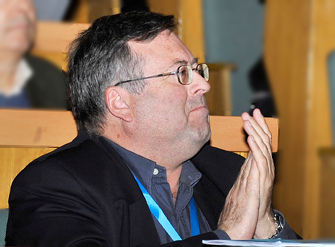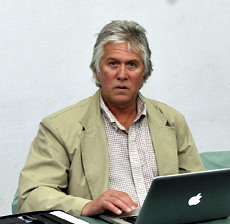Director's Corner
22 April 2010
 Barry Barish |
ILC-CLIC general issues group
At the Beijing meeting, Philippe Lebrun gave a report to the Global Design Effort Executive Committee of the initial work of the new “ILC-CLIC general issues group.” This working group consists of Philippe Lebrun (co-chair), Ken Peach and Daniel Schulte from the Compact Linear Collider (CLIC) Study, and Mike Harrison (co-chair), Kaoru Yokoya and Eckhard Elsen from the GDE. The group has reviewed its mandate, surveyed the progress of the joint ILC-CLIC working groups and planned its future activities.
The mandate for the general issues group was formed at the initiative of the leadership teams of the ILC-GDE and CLIC and has been endorsed by the oversight committees of both projects. In fact these committees determined that the work of the group is so important that it should report directly to them. The actual mandate is given below:
 Philippe Lebrun, CLIC general issues group co-chair, in Beijing. Image: IHEP/Jie Liu. Philippe Lebrun, CLIC general issues group co-chair, in Beijing. Image: IHEP/Jie Liu. |
 Mike Harrison, GDE general issues group co-chair, also in Beijing. Image: IHEP/Jie Liu. Mike Harrison, GDE general issues group co-chair, also in Beijing. Image: IHEP/Jie Liu. |
ILCSC [International Linear Collider Steering Committee] and CSC [CLIC Steering Committee] have approved formation of a ILC-CLIC general issues working group by the two parties with the following mandate:
- Promoting the Linear Collider
- Identifying synergies to enable the design concepts of ILC and CLIC to be prepared efficiently
- Discussing detailed plans for the ILC and CLIC efforts, in order to identify common issues regarding siting, technical issues and project planning.
- Discussing issues that will be part of each project implementation plan
- Identifying points of comparison between the two approaches .
The conclusions of the working group will be reported to the ILCSC and CLIC Collaboration Board with a goal to producing a joint document.
The first accomplishment of this new committee reported by Philippe Lebrun has been to survey the work of the joint ILC-CLIC working groups. He presented a nice group-by-group summary of that work at our meeting. The working groups include ones on beam delivery systems and machine-detector interfaces, civil engineering and conventional facilities, positron generation, damping rings, beam dynamics, and cost and schedule. From this survey, the general issues group is trying to identify the areas of greatest promise for future synergies between CLIC and ILC.
As reported, all the topical working groups have been operating since 2008, with some pre-history through the European EUROTeV project. The groups typically have monthly meetings by WebEx, as well as face-to-face meetings during ILC or CLIC events. The membership of the groups is truly international, involving many labs and institutes and ranging from 7 to 37 participants. From the survey many benefits were cited by the groups: strengthening of ties between CLIC and ILC study teams; improved collaboration among stakeholders in community beyond CLIC/ILC; peer contribution/expertise on topics of common concern; pooling of expert resources; identification of potential issues; sharing of experience, methods and tools for efficiency and mutual transparency; benchmarking of codes and agreement on standards; and access to experimental facilities. The responses to the main difficulties cited: time spent on project-specific items with little common interest; and finally, lack of resources (!). Overall, the conclusion of Lebrun is that the joint working groups are quite productive.
They also summarised the present plans of the joint working groups during the ILC Technical Design Report period up to 2012. Perhaps the most important are the plans for cost and schedule, including sharing of mutual information on CLIC and ILC cost estimations, facilitating comparisons, as well as serving on each others' internal review boards. Our hope is by working together in this way we will both make the work of both groups on costing better and more reliable, and also enable meaningful comparisons that can help both projects or provide comparative information as part of any decision-making process in the future.
-- Barry Barish